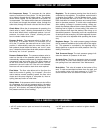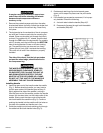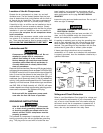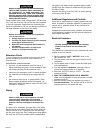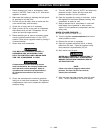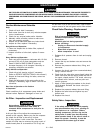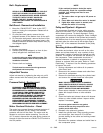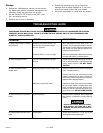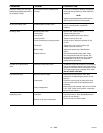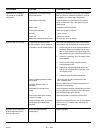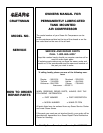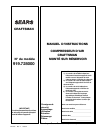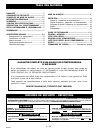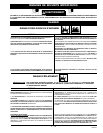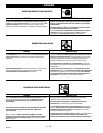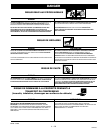
15 — ENG
D21245
Pressure reading on the regu-
lated pressure gauge drops when
an accessory is used.
Air leak from safety valve.
Knocking noise
If there is an excessive amount of pressure
drop when the accessory is used, adjust the
regulator.
NOTE
Adjust the regulated pressure under flow con-
ditions (while accessory is being used).
Operate safety valve manually by pulling on
ring. If valve still leaks, it should be
replaced .
Remove and clean or replace.
Torque pulley set screw.
Maintain prescribed oil level. Add oil.
Torque screw 15-20 ft. lbs.
Check screws. Torque as required (15-20
ft.-lbs.)
Tighten wing nut until it contacts the
washer, plus one more turn.
Adjust belt tension (see "Belt Replace-
ment".)
Remove the head and valve plate. Clean
the valve plate and top of the piston. (Be
sure carbon does not fall into the cylinder.)
Reassemble to 25-30 ft. lbs. using new
gasket and torque screws.
It is normal for some pressure drop
to occur.
Possible defect in safety valve.
Defective check valve.
Loose pulley.
Low oil level.
Loose flywheel.
Loose compressor mounting screws.
Loose belt.
Belt too tight.
Carbon build-up.
PROBLEM
CAUSE CORRECTION
Air leaks at or inside check
valve.
Defective or dirty check valve. A defective check valve results in a constant air
leak at the pressure release valve when there is
pressure in the tank and the compressor is shut
off. Remove and clean or replace check valve.
DO NOT OVER-TIGHTEN.
Excessive belt wear.
Squealing sound.
Belt is too loose or tight.
Loose pulley.
Pulley misalignment.
Loose belt.
There is no oil in the compressor.
Adjust tension instructions. (See "Belt
Asjustment or Replacement" section in this
manual.
Check for worn keyway or pulley bore. Also
check for bent motor shaft. Replace parts if
necessary.
Motor pulley and flywheel must be in line within
1/32". (See "Pulley and Flywheel - Alignment"
section in this manual.)
Adjust belt tension. (See "Belt Replacement"
section in this manual.)
Add oil to top of fill hole in base.



